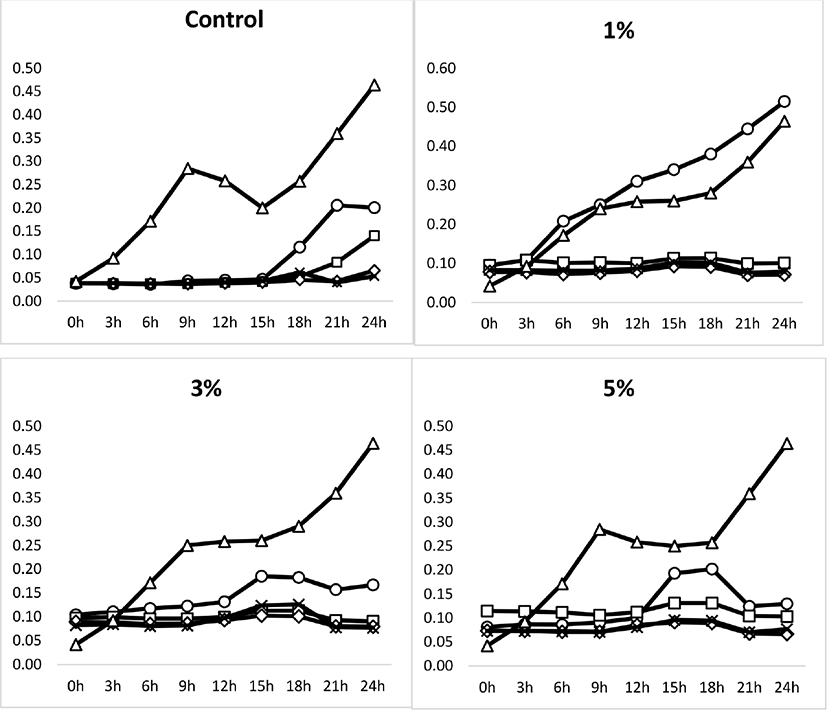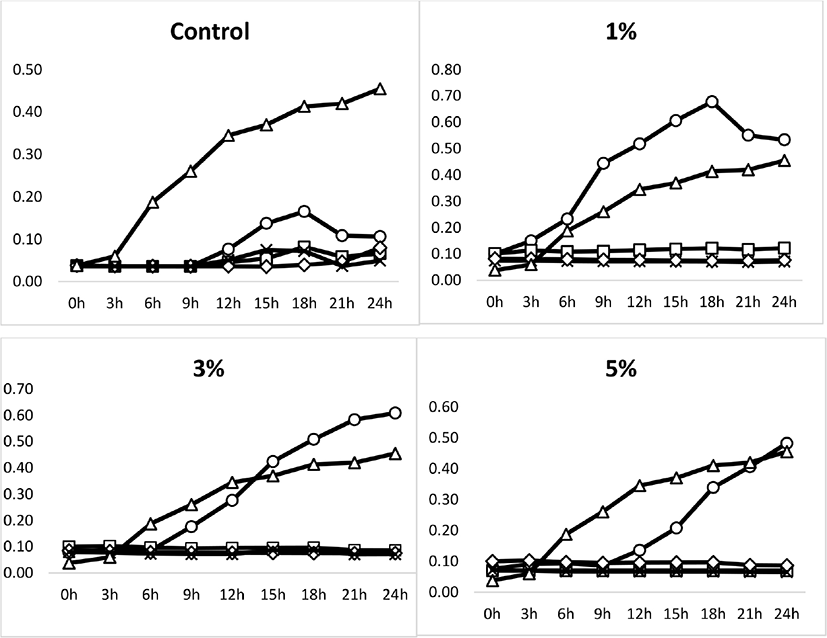서 론
우리나라 국민들은 소득 수준이 향상됨에 따라 건강에 관한 지속적인 관리를 진행하고 있으며, “웰빙” 시대를 맞이하여 기능성 식품의 소비가 매년 증가하고 있다. 특히 현대인들은 사회생활을 하면서 스트레스로 인한 장 기능의 약화 증세에 도움이 되는 발효유의 소비량은 매년 꾸준히 증가하고 있는 추세이다. 국내 발효유의 소비량과 생산량은 유제품 중 시유 다음으로 두 번째로 차지하고 있다. 통계청에서 실시한 2017년 우유 및 유제품 생산 현황 조사결과, 우리나라 전체 국민의 연간 발효유 소비량이 약 55.5만 t으로 전년 대비 약 4만 t 증가한 것으로 집계되었다[1].
발효유의 건강 증진 효과는 유산균과 유산균 배양 중에 형성된 대사산물이 장내 부패균의 성장 저해 작용을 일으키는데 근거를 두고 있다. 유산균 발효유의 건강증진 효과에 대해서는 Metchnikoff의 불노장수설[2]에서 시작하여 많은 연구자에 의하여 장 운동 조절, 유산균에 의한 장내 균총의 균형 유지에 의한 소화기 건강[3], 병원성 세균의 억제, 소화 흡수의 촉진, 변비, 설사 등의 효과 이외에 영양생리적인 건강증진 작용 혹은 항암 기능[4] 등과 같은 질병 억제 작용에 대한 과학적인 연구에 기초를 두고 있다.
돼지감자(Helianthus tuberosus)는 국화과 해바라기속의 여러해살이 식물로 한대지역에서 온대지역까지 전 세계적으로 재배되고 있으며, 돼지감자, 뚱딴지 등으로 불리고 있다[5-7]. 돼지감자는 민간요법에서 당뇨병과 류마티스 치료를 위해 사용되어 왔으며, 변비 개선, 장 질환 예방, 대장암 발생 억제, 혈청 콜레스테롤 감소, 혈중 지질 저하, 혈당 강화 및 비만 개선 효과 등 다양한 약리 활성이 있는 것으로 알려져 있다[8].
돼지감자의 주요 성분은 fructose 분자들이 β-2, 1 결합으로 연결되어 있는 inulin이며, 인간의 위에서는 분해되지 않고 장내 미생물에 의하여 발효되어 배변기능 촉진에 효과가 있다. 또한, 분해되어도 혈당치를 급격하게 상승시키지 않고 열량이 낮아 비만개선 효과와 중성지질의 감소효과 등이 보고되었다[9,10].
본 연구는 다양한 생리활성 기능이 있는 돼지감자 분말을 첨가한 발효유를 제조하여 이화학적 특성을 조사하고, 그 결과를 유가공산업에 기초 자료로 응용하기 위하여 수행하였다.
재료 및 방법
본 실험에 사용된 탈지분유(서울우유, 한국)에서 제조한 것으로 재료의 화학적 조성은 Table 1과 같으며, 10% 환원탈지유를 90°C에서 10분간 살균하여 사용하였다.
| Material | Composition (% of DM) | ||||
|---|---|---|---|---|---|
| Moisture | Protein | Fat | Ash | Carbohydrate | |
| Skim milk powder | 7.12 | 31.84 | 0.09 | 7.82 | 51.13 |
돼지감자 발효유 제조에 사용한 starter는 혼합균주(ABT-4: Lactobacillus acidophilus, Streptococcus thermophiles, Bifidobacterium sp. CHR HANSEN Co., Denmark)를 냉동 보관하여 사용하였고, MRS broth에 접종하여 37°C에서 48시간 동안 배양하였다. 초기 균수는 1.13×108이다.
실험에서 사용된 돼지감자 분말(Helianthus tuberosus powder, HP)은 Goodlife365에서 구매한 분말을 사용하였다. 돼지감자 분말의 일반 성분은 수분 3.62±0.01 g, 탄수화물 78.41±0.60 g, 조단백질 10.83±1.13 g, 조지방 0.60±0.03 g, 조회분 6.61±0.32 g, 식이섬유소 함량은 14.74 ±0.45 g이었으며, 나트륨 함량은 10.32±0.23 mg이다[4].
10% 환원탈지유 500 mL에 HP를 1.0%, 3.0%, 5.0%를 혼합한 다음 멸균 후 starter를 3% 접종하고, 0, 4, 8, 16, 24, 48시간별로 37°C에서 배양하였다. 배양이 끝난 후 4°C 냉장고에서 24시간 냉각하 였다.
돼지감자 발효유를 0, 4, 8, 16, 24, 48시간 배양 후 pH와 적정산도를 측정하였다. pH측정은 pH측정기(S20 Seven EasyTM pH, Meter Toledo AG, Schwerzenbach, Switzerland)로 측정하였다. 적정 산도는 시료 9 g에 증류수 9 mL와 phenolphthalein 지시약 0.5 mL를 첨가한 후, 0.1 N NaOH로 적정하여 계산하였다.
생균수는 0, 4, 8, 16, 24, 48시간 동안 배양한 발효액을 Marshal(1993)[11]의 방법에 따라 10진 희석 후 standard plate count(SPC)법에 따라 BCP agar(Eiken Chmical Co., Ltd. Shimotsugagun, Tochigi, Japan)에 분주하여 48시간 배양 후 colony의 수가 30–300개 범위로 나타낸 평판을 선별하여 log CFU(colony forming unit)/g으로 표시하였다.
발효유를 원심분리기(Mega 17R, Hanil Science Industrial, Korea)를 사용하여 3,700×g에서 10 min 동안 원심분리하였다. 분리된 상등액을 채취하여 0.2 μM membrane filter를 사용하여 여과 후 HPLC system(600E Multisolvent Delivery System, Waters Associates, USA)을 사용하여 유기산 분석 및 당 성분을 분석하였다. 시료는 7725 injector(Rheodyne, USA)를 사용하여 20 μL를 주입하였고, Detector는 유기산은 Saidi와 Warthesen[12], UV Detector(2487 UV detector, Waters Associate., USA), 당은 Refractive Index Detector(2410 RI Detector, Waters Associates., USA)를 사용하였다. Column은 유기산과 당 전환 분석은 SUPELCOGEL C-610H(38 cm×7.8 mm, Sigma-Aldrich Co., USA)을 사용하였고, column의 온도는 Waters Column Heater Module(serial #F98CHM095M)을 사용하여 40°C를 유지하였다. 이동상은 유기산과 당 분석은 HPLC용 Water(TEDIA Company Inc., USA)와 0.1% Phosphoric acid를 사용하여 1.0 mL/min의 유속으로 40분 동안 분석하였다. 실험에 사용된 표준물질은 Sigma-Aldrich Co. (Darmstadt, Germany)에서 구입하여 분석에 사용하였다.
에탄올에 녹은 0.2 mM DPPH에서 0.8 mL를 가지고 Sample 0.2 mL에 첨가하여 혼합한 후 어두운 곳에서 25°C로 10분간 방치시켰다. Sample은 900×g에 1분 원심 분리하여 상등액을 ELIZA reader를 이용하여 490 nm에서 흡광도를 측정하였다. 총 phenolics 함량은 Folin Denis법[13]으로 측정하였다. 적당히 희석한 추출 물 0.5 mL를 시험관에 분주하고, 25% Na2CO3 용액 0.5 mL를 첨가하여 3분간 정치시켰다. 다시 2N Folin-Ciocalteu phenol 시약 0.25 mL를 첨가하여 혼합한 다음 30°C에서 30분 동안 정치하여 발색시켰다. 발색된 청색을 750 nm에서 분광광도계(Spectronic 2D, Thermo Spectronic, Rochester, NY, USA)를 사용하여 흡광도를 측정하였다. 이때 총 phenolics 함량은 gallic acid를 이용하여 작성한 표준곡선에서 함량을 구하였다. 각 실험은 3회 반복하여 평균값으로 나타내었다.
결과 및 고찰
발효 중 pH의 변화는 Fig. 1에 나타난 바와 같이, 대조구보다 돼지감자 분말 첨가구에서 발효 시간이 길어질수록 pH 값이 감소하였다. 또한, 돼지감자 분말 처리구의 pH값이 대조구에 비해 빠르게 감소되다가 16시간 이후부터 첨가구의 pH값이 더 낮게 측정되었는데, 최종 발효 48시간에서 대조구 3.7, 처리구 1%, 3%, 5%는 각각 3.65, 3.63, 3.59로 pH가 빠르게 떨어진 것을 알 수 있었다. 돼지감자 분말이 유산균의 대사활동에 영향을 미친 결과, 유기산 증가에 영향을 미치는 것을 알 수 있었다. 이는 뽕잎추출액을 첨가한 발효유의 pH변화와 동일한 결과를 얻었다[14]. 산도 변화는 최종 48시간 발효에서 대조구 2.35, 1%, 3%, 5% 첨가구에서 각각 2.57, 2.93, 3.17로 발효 시간이 경과함에 따라 산도가 높게 나타났다.
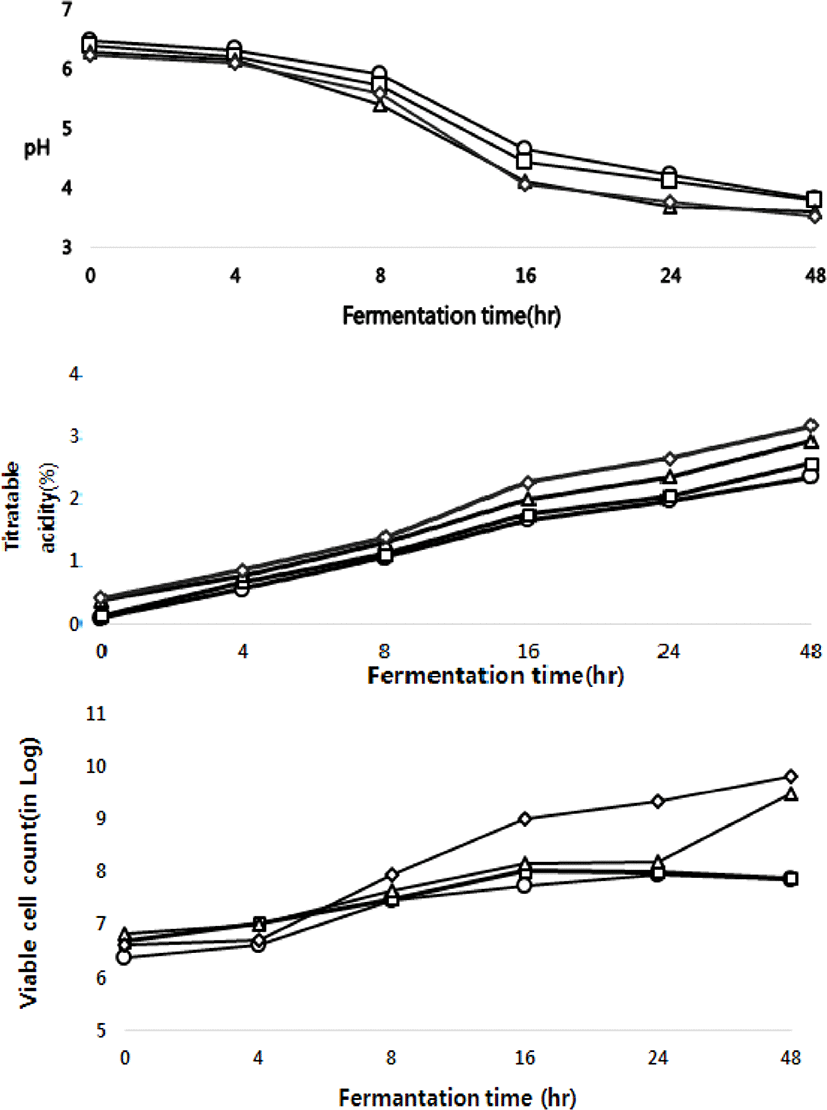
발효 중 유산균 수의 변화는 Fig. 1에 나타난 바와 같다. 5% 첨가구에서 16시간 발효 후 유산균 수가 9.96 log CFU/g으로 가장 높게 측정되었고, 대조구와 1%, 3% 처리구는 각각 9.79, 9.91, 9.89 log CFU/g으로 유산균의 수가 거의 비슷한 것으로 나타났다. 이는 발효유 제조과정 중 유산균의 증식단계에서 돼지감자가 가지고 있는 영양성분에 의한 것으로 기인되며, pH측정 결과와 마찬가지로 돼지감자 분말이 유산균 생존에 유리하게 작용하는 것으로 나타났다. 이는 옥수수를 첨가한 요구르트의 결과와 유사하다[15].
발효유 중 유기산의 변화는 Fig. 2와 같다. 돼지감자 분말 첨가량이 증가함에 따라 oxalic acid와 tartaric acid는 감소되었고, lactic acid가 증가되는 경향을 보였다. 특히 lactic acid는 발효 16시간부터 크게 증가하는 경향을 보였다. 돼지감자에 함유된 유기산의 종류를 보면 citric acid, malic acid, succinic acid였으며, 함량은 malic acid가 가장 높았고, 다음으로 citric acid로 나타났다[16].
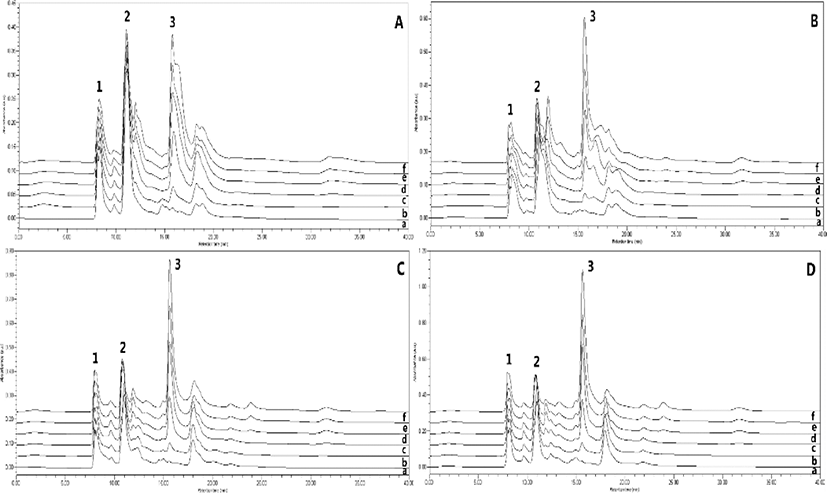
발효유 중 당 성분의 변화는 Fig. 3과 같다. 발효 초기의 lactose는 발효가 진행되면서 glucose와 galactose로 분해되었고, 발효 시간이 경과함에 따라 glucose는 점차 감소되었다. 발효 16시간 이후부터는 glucose가 고갈되었다. 돼지감자의 유리당 종류는 sucrose, fructose, galactose, glucose로 나타났으며, sucrose의 함량이 가장 높았다[17].
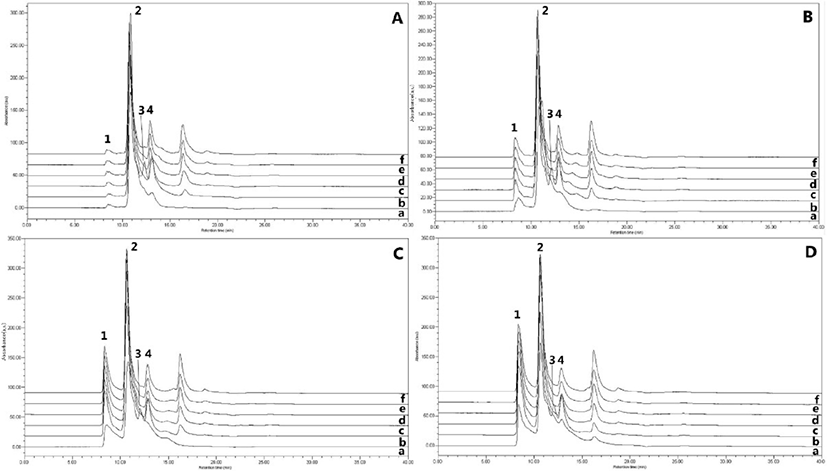
돼지감자 발효유의 항산화 효과는 Fig. 4에 나타난 바와 같다. 최종 발효 시간인 48시간 때 대조구는 80.39%로 나타났고, 1%, 3%, 5% 처리구들은 각각 79.5%, 81.42%, 84.14%로 돼지감자분말 첨가 량이 증가하고 발효 시간이 길어질수록 항산화 효과가 높게 조사되었다. 다른 돼지감자 항산화 검사에서 에탄올 추출물로 검사하였을 때 모두 5.0 mg/mL의 시료의 농도에서 66.41%, 53.37%의 활성을 나타내었다[18].
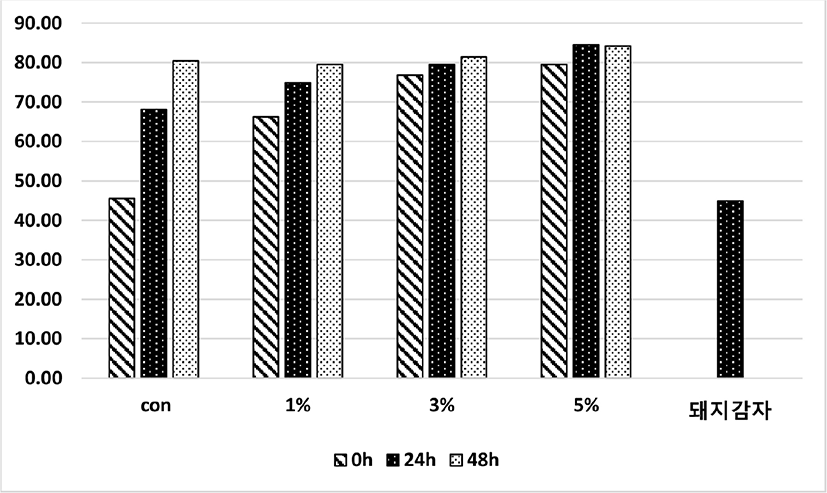
돼지감자분말의 폴리페놀은 1 g당 1.6 g/g으로 조사되었다. 폴리페놀성 물질은 항산화, 항염, 항균 등 다양한 생리활성을 나타내는 항산화의 지표물질로써[17] 돼지감자에는 다양한 폴리페놀 화합물이 함유되어 있다고 보고하였다[19-21].
돼지감자 발효유의 점도는 Fig. 5에 나타난 바와 같다. 8시간 발효에서 3%, 5% 첨가구는 각각 462 cP, 604 cP로 높게 나타났으나, 대조구는 17.1 cP, 1% 첨가구는 21.6 cP로 점도에 큰 변화가 없었다. 그러나 16시간 발효부터 대조구 450 cP, 1% 첨가구는 616 cP로 급격히 증가하였다. 최종 48시간 발효에서는 대조구 1,006 cP, 1%, 3%, 5% 첨가구는 각각 1,026 cP, 1,040 cP, 1,106 cP로 돼지감자 첨가 함량이 높을수록 점도가 높게 측정되었다. 일반적으로 점성의 원인이 되는 curd는 유산 발효 시 우유 단백질의 등전점 침전, protease에 의한 분해 응고 및 유산균에 의한 polysaccharide의 생성 등에 의해 복합적으로 일어난다고 보고되어 있다[22]. 또한 전분 및 섬유소 등에 의해서도 점도가 상승할 수 있다고 보고하였다[15].
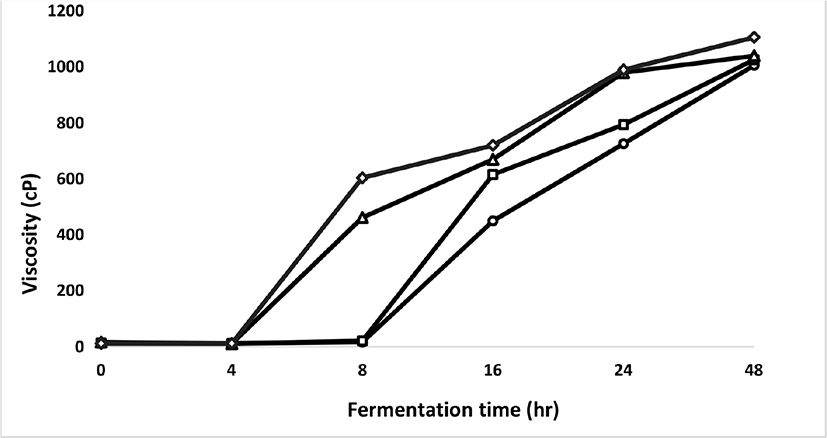
발효시료에 E. coli 에 관한 항균 효과는 Fig. 6에 나타난 바와 같다. 48시간 배양 시 대조구는 0.46으로 조사되었고, 1%, 3%, 5% 첨가구는 모두 0.08로 돼지감자 분말 첨가량이 높은 발효유일수록 또한 발효 시간이 길수록 항균효과가 더 높게 나타났다. Staphylococcus aureus에 관한 항균 효과는 Fig. 7에 나타난 바와 같다. 48시간 배양한 대조구는 0.46이었고, 1%, 3%, 5% 첨가구는 0.08, 0.07, 0.07로 조사되어 돼지감자 분말 첨가량이 많은 발효유일수록 또한 발효 시간이 길수록 항균효과가 더 높게 나타났다. 이러한 이유는 유산균은 유산 및 초산과 같은 대사산물을 생산함으로써 pH를 낮추어 유해균의 생장을 억제[23]하고, 유산균이 생산하는 초산과 프로피온산은 세포막과 상호반응하여 세포내 산성화와 단백질 변성을 유발시킨다[24].
